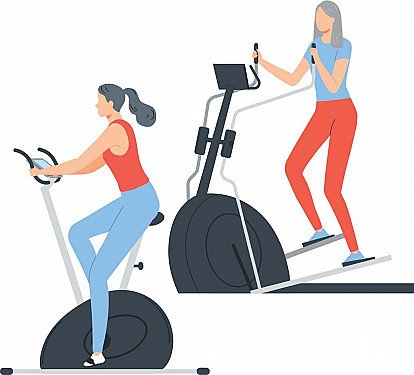The new exercise guidelines: Any changes for you?

It's likely you already know that regular exercise helps prevent chronic disease, such as diabetes and heart problems, while improving your overall health, mood, and quality of life. It can sharpen mental function, boost concentration, and help you sleep. And the new exercise and physical activity guidelines issued by the federal government's Office of Disease Prevention and Health Promotion show that the dose required to gain these benefits is not hard to achieve. The new guidelines are better tailored for age and ability, too.
What should your exercise goals be?
The amount of exercise and mix of activities recommended varies depending on age and ability, as described more fully below. It ranges from a high of three hours daily — for preschoolers, who tend to love activity — to 150 minutes a week.
Unfortunately, 80% of the population is not meeting the guidelines. Each year in the US, an estimated 10% of premature deaths and $117 billion in healthcare costs are associated with inadequate physical activity.
Besides saving money on healthcare, there are many personal benefits to staying active. The new guidelines highlight other new evidence-based findings related to physical activity and exercise.
What changed in the new exercise guidelines?
- Overall, move more, sit less. Work toward reducing the amount of time you spend sitting every day. If you have a desk job, get up to walk around regularly, or try chair yoga or a few desk exercises.
- All activity counts toward the recommended goals — not just 10-minute bouts of activity, as past guidelines recommended.
- Younger people and older people may benefit in different ways from exercise. It facilitates normal growth and development for preschoolers through teens, strengthening bones and muscles and improving cardiovascular health. Older adults who participate in regular exercise have better balance, and lower risks of falling and injury, thus improving their ability to remain independent.
The new guidelines base your dose of physical activity on relative intensity: how much effort a given exercise takes compared with your capacity for exercise. A brisk walk counts as moderate physical activity (think: fast enough so that you can speak comfortably, but not sing). The speed of this walk will be much faster for someone who is in shape than for someone who is just starting to exercise or getting back to activity after a break. But no matter where the starting line is, most people can safely improve their fitness and health. Begin with lower amounts of exercise and slowly increase duration, intensity, and frequency.
For example, if you:
- Have been bed-bound, start by walking two minutes every 10 to 15 minutes (during commercial breaks when watching TV or listening to the radio).
- Typically walk for exercise, try adding an extra block to your regimen once a week.
- Jog, try going at your regular pace for five minutes, then increasing it for one minute.
What stayed the same in the new exercise guidelines?
- Exercise is safe for almost everyone — even people with chronic disease and disabilities.
- Different types of exercise have complementary benefits:
- Aerobic activity, like walking, running, or cycling, improves cardiovascular health. It involves movement of the large muscles of the body for sustained periods of time.
- Muscle-strengthening activity, like resistance training with elastic bands or weight lifting, improves muscle strength, endurance, power, and mass.
- Bone-strengthening activity, like running, playing basketball, resistance training, or jumping rope, improves bone health and strength.
- Balance activity, like walking backwards, standing on one leg, yoga, and tai chi, can reduce fall risk.
- Multicomponent physical activity, like running, dancing, or playing tennis includes at least two of the above types of activity.
- Rating the intensity of activities is simple. During:
- Light activity, you don't feel like you're exerting yourself.
- Moderate activity, you can talk comfortably, but not sing.
- Intense activity, you can say a few words, but not full sentences. Within the guidelines, one minute of intense activity is roughly equivalent to two minutes of moderate activity.
New exercise recommendations by age and ability
- Preschool-age (3 through 5 years): physically active throughout the day with the goal of three hours of activity daily
- Children and teens (6 through 17 years): at least 60 minutes daily of moderate-to-vigorous physical activity; include vigorous activity, muscle-strengthening, and bone-strengthening activity three times a week
- Adults: at least 150 to 300 minutes weekly of moderate-intensity aerobic activity, or 75 to 150 minutes weekly of vigorous-intensity aerobic activity, or an equivalent combination of both, plus muscle-strengthening activities on at least two days a week
- Older adults: multicomponent physical activities that mix balance activities, aerobic activities, and strength training can help prevent falls and injuries; reduce overall sitting and replace it with light (or when possible, moderate) activity
- Pregnant and postpartum women: at least 150 minutes weekly of moderate-intensity aerobic activity
- Adults with chronic conditions or disabilities: follow adult guidelines as able, including both aerobic and muscle-strengthening activities
About the Author

Lauren Elson, MD, Contributor; Editorial Advisory Board Member, Harvard Health Publishing
Disclaimer:
As a service to our readers, Harvard Health Publishing provides access to our library of archived content. Please note the date of last review or update on all articles.
No content on this site, regardless of date, should ever be used as a substitute for direct medical advice from your doctor or other qualified clinician.















